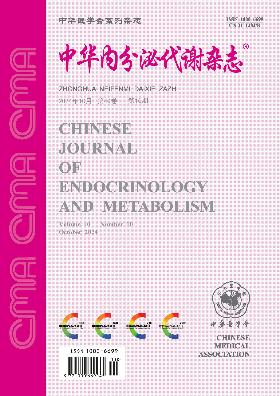Analysis on clinical features of 106 type 2 diabetic patients complicated with insulin autoimmune syndrome
Q4 Medicine
引用次数: 0
Abstract
Objective To analyze the clinical features of type 2 diabetic patients with insulin autoimmune syndrome after treatment with exogenous insulin. Methods A total of 106 patients with type 2 diabetes diagnosed with exogenous insulin-related insulin autoimmune syndrome (EIAS) were included from September 2017 to March 2019 in the Department of Endocrinology, Zhongshan Hospital, Fudan University. The clinical data, physical examination, and laboratory examination results of patients were collected. Results Of the 106 patients, 84 (79.24%) used premixed human insulin or premixed insulin analogs, and 18 patients (16.98%) presented recurrent hypoglycemia. The arginine stimulation test showed that the median value of the baseline insulin was 73.40 (23.07-146.75) μU/ml, and the median ratio of 4 minute insulin to 0 minute insulin was 1.27 (1.03-1.85), with the mean of the ratio 1.72±1.47. The ratio of baseline insulin (μU/ml) to C-peptide (ng/ml) was 44.60 (14.92-87.93), with an average of 81.92±130.93. Taking the two-fold upper limit of fasting insulin reference value (49.8 μU/ml) as the cut-off point, the subjects were divided into insulin accumulation group (baseline insulin≥49.8 μU/ml) and insulin non-accumulation group (baseline insulin <49.8 μU/ml). Among the 66 patients in the insulin accumulation group, 14 patients had hypoglycemia (21.21%) and 4 patients in the insulin non-accumulation group presented hypoglycemia (10%). The ratio of 4 minute insulin to baseline insulin, ratio of baseline insulin to C-peptide, blood glucose level standard deviation (SDBG) and maximum blood glucose fluctuation amplitude (LAGE) in the insulin accumulation group were significantly higher than those in the insulin non-accumulation group (all P<0.05). Among 66 patients in the insulin accumulation group, 36 patients changed the type of insulin preparafion (insulin treatment group), 30 patients were changed from insulin to oral hypoglycemic agents (oral medication group). After treatment, both SDBG and LAGE in the two groups were significantly lower than before treatment (P<0.05). Conclusions With the aggravation of exogenous insulin accumulation, the fluctuation of blood glucose and the proportion of hypoglycemia were significantly increased. There was a characteristic change in islet function in patients with insulin autoimmune syndrome. After arginine stimulation, there was no significant peak of insulin secretion, showing a " high-level" curve. The baseline insulin/C-peptide ratio was significantly increased. The prognosis of EIAS patients is good after timely diagnosis and adjustment of treatment. Key words: Diabetes mellitus, type 2; Insulin autoantibody; Exogenous insulin-related insulin autoimmune syndrome106例2型糖尿病合并胰岛素自身免疫综合征的临床特点分析
目的分析外源性胰岛素治疗后2型糖尿病合并胰岛素自身免疫综合征的临床特点。方法选取2017年9月至2019年3月复旦大学中山医院内分泌科诊断为外源性胰岛素相关胰岛素自身免疫性综合征(EIAS)的2型糖尿病患者106例。收集患者的临床资料、体格检查及实验室检查结果。结果106例患者中,84例(79.24%)使用预混合人胰岛素或预混合胰岛素类似物,18例(16.98%)出现反复低血糖。精氨酸刺激试验显示,基线胰岛素的中位数为73.40 (23.07-146.75)μU/ml, 4分钟胰岛素与0分钟胰岛素的中位数比值为1.27(1.03-1.85),平均值为1.72±1.47。基线胰岛素(μU/ml)与c肽(ng/ml)之比为44.60(14.92 ~ 87.93),平均值为81.92±130.93。以空腹胰岛素参考值的两倍上限(49.8 μU/ml)为分界点,将受试者分为胰岛素蓄积组(基线胰岛素≥49.8 μU/ml)和胰岛素非蓄积组(基线胰岛素<49.8 μU/ml)。胰岛素蓄积组66例患者中有14例出现低血糖(21.21%),非胰岛素蓄积组有4例出现低血糖(10%)。胰岛素积累组4分钟胰岛素与基线胰岛素之比、基线胰岛素与c肽之比、血糖水平标准差(SDBG)和最大血糖波动幅度(LAGE)均显著高于胰岛素非积累组(P<0.05)。胰岛素积累组66例患者中,36例患者改变胰岛素制剂类型(胰岛素治疗组),30例患者由胰岛素改为口服降糖药(口服用药组)。治疗后,两组患者SDBG、LAGE均显著低于治疗前(P<0.05)。结论随着外源性胰岛素积累的加重,血糖波动和低血糖比例明显增加。胰岛素自身免疫综合征患者胰岛功能有特征性改变。精氨酸刺激后,胰岛素分泌无明显高峰,呈“高水平”曲线。基线胰岛素/ c肽比值显著升高。经及时诊断和调整治疗,EIAS患者预后良好。关键词:糖尿病;2型;胰岛素自身抗体;外源性胰岛素相关的胰岛素自身免疫性综合征
本文章由计算机程序翻译,如有差异,请以英文原文为准。
求助全文
约1分钟内获得全文
求助全文
来源期刊

中华内分泌代谢杂志
Medicine-Endocrinology, Diabetes and Metabolism
CiteScore
0.60
自引率
0.00%
发文量
7243
期刊介绍:
The Chinese Journal of Endocrinology and Metabolism was founded in July 1985. It is a senior academic journal in the field of endocrinology and metabolism sponsored by the Chinese Medical Association. The journal aims to be the "Chinese broadcaster of new knowledge on endocrinology and metabolism worldwide". It reports leading scientific research results and clinical diagnosis and treatment experience in endocrinology and metabolism and related fields, as well as basic theoretical research that has a guiding role in endocrinology and metabolism clinics and is closely integrated with clinics. The journal is a core journal of Chinese science and technology (a statistical source journal of Chinese science and technology papers), and is included in Chinese and foreign statistical source journal databases such as the Chinese Science and Technology Papers and Citation Database, Chemical Abstracts, and Scopus.
 求助内容:
求助内容: 应助结果提醒方式:
应助结果提醒方式:


